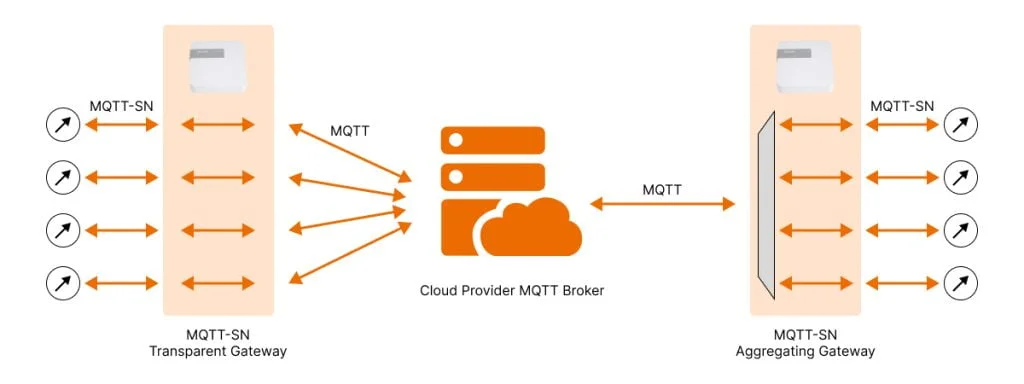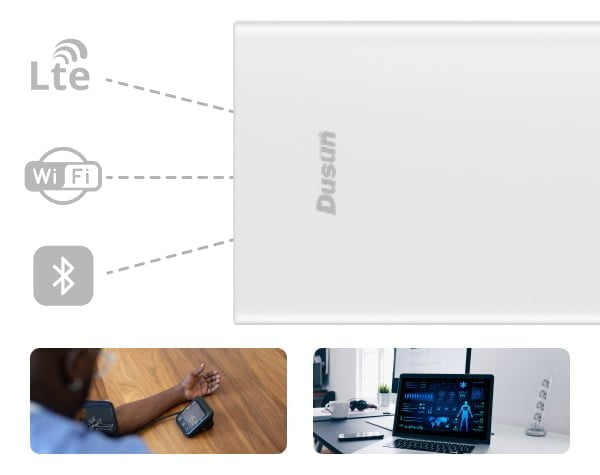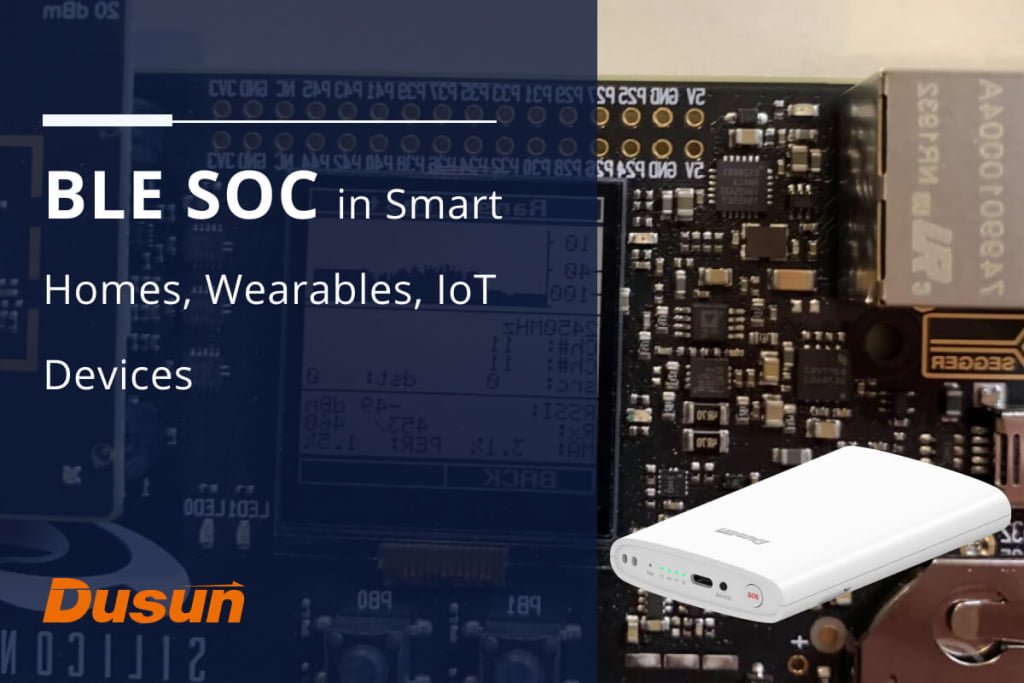A BLE SoC is a type of BLE chip that integrates multiple components onto a single chip. This allows for a more compact and efficient design, as all of the necessary components are contained on a single chip. BLE SOC is Widely used in IoT gateways to participate in various IoT projects.
- nRF52 Series (Nordic)- Low power consumption, extensive features, strong developer ecosystem.
- CC26xx Series (Texas Instruments)- Power-efficient, comprehensive development support, suitable for various applications.
- PSoC 6 BLE (Cypress)- Flexible integration, USB and CapSense support, ample memory options.
- DA1458x Series (Dialog)- Low power consumption, compact size, suitable for space-constrained devices.
- EFR32 Series (Silicon Labs)- Power efficiency, wide range of peripherals, robust development support.
- QCA402x (Qualcomm)- High clock speed, audio support, suitable for audio and voice applications.
This article introduces a variety of high-performance BLE SOCs to help you choose the most suitable one.
What is BLE SOC?
In order to create a completely compliant Bluetooth device, the single-chip BLE SoC is a monolithic component developed in a typical digital CMOS process.
Devices that need low-power wireless communication, such as wearables, fitness trackers, smartwatches, medical devices, Internet of Things (IoT) devices, and more, typically employ BLE SOCs.
You may be interested in Why Choose Wireless SoCs for IoT Hardware Development & How to Select
Why BLE SOC is needed for IoT?
Low Power Consumption
BLE SOCs are perfect for battery-powered devices since they are made with minimal power consumption in mind. They include energy-saving functions including sleep modes, effective data transmission protocols, and improved radio frequency performance. This enables gadgets to have longer battery lives, which makes them appropriate for wearable technology, IoT technology, and other portable applications.
Wireless Connectivity
BLE SOCs allow for Bluetooth-enabled devices to connect wirelessly and interact with one another as well as with other Bluetooth-enabled devices, such as computers, tablets, and smartphones. The contact with external devices, control of the gadget, and seamless data transfer are all made possible by this connectivity. BLE is perfect for Bluetooth IoT devices and sensors since it is particularly well-suited for applications requiring intermittent data exchange or low bandwidth.
Compatibility
The Bluetooth Low Energy standard compliance of BLE SOCs ensures compatibility and interoperability with a variety of Bluetooth-enabled devices. Due to this standardisation, devices using BLE SOCs may smoothly connect and interact with one another independent of the maker or platform.
Integration and Miniaturization
By integrating several parts and functions onto a single chip, BLE SOCs help devices become smaller and simpler. Through this integration, the design and production processes are made simpler, the cost is reduced, and smaller, lighter devices are now possible. It is especially useful for wearable technology such as remote patient monitoring wearables, where form factor and size are important factors.
Program Development
BLE SOCs usually provide software development kits (SDKs) and support for a variety of programming languages, which makes it easier to design applications. Designing cutting-edge features like data synchronization, wireless updates, and proximity-based interactions is made simpler by these SDKs’ tools, frameworks, and APIs.
A multitude of hardware development resources, including SDK and burning tools, are provided by Dusun IoT to aid the developer in finding the ideal solution for his particular requirements.
How is a BLE SOC measured?
Taking into account numerous performance metrics, a data-based and thorough methodology is needed to evaluate the quality of a BLE SOC. Here are some important aspects to take into account while assessing a BLE SOC’s level of quality:
Consumption of energy
A BLE SOC’s power consumption is an important consideration, particularly for battery-powered devices. It is crucial to gauge the SOC’s power utilization in a variety of conditions, including active communication, idle mode, and sleep mode. Data like current consumption in various operational modes and the effects of various transmission power levels may be used to evaluate the SOC’s power efficiency.
Distance and Signal Power
The BLE SOC’s capacity to create and sustain connections with other devices depends on its range and signal strength. The performance of the SOC may be determined by analyzing the connection quality, signal-to-noise ratio (SNR), and received signal strength indicator (RSSI) at different locations and at varying distances. Its resilience and dependability may be evaluated by testing under various conditions, such as line-of-sight, blocked surroundings, or interference-prone places.
Throughput of data
The speed of data transmission between devices depends on the data throughput of a BLE SOC. The effectiveness of the SOC in processing data may be determined by measuring the attainable data transmission rate under various conditions, such as varied distances and degrees of interference. To make sure that data transmission is smooth and dependable, factors including packet loss, latency, and data rate variations should be considered.
BLE SOC in the IoT market
- nRF52 Series: Wearables, smart home appliances, and industrial IoT all make use of Nordic Semiconductor’s nRF52 family, which is well known for its low power consumption and sophisticated functionality.
- CC26xx Series: The CC26xx line from Texas Instruments offers low-power, high-performance solutions appropriate for a variety of uses, including building automation, asset monitoring, and healthcare.
- PSoC 6 BLE: The PSoC 6 BLE SOC from Cypress Semiconductor combines BLE connection with a configurable MCU architecture in a way that makes it simple to integrate custom features and increases design freedom.
- DA1458x Series: The DA1458x family from Dialog Semiconductor is renowned for its very low power consumption and small design, making it ideal for tiny, battery-operated gadgets like wearables and beacons.
- EFR32 Series (e.g., EFR32BG, EFR32MG): The EFR32 series from Silicon Labs provides a selection of BLE SOCs with varied features and performance levels, addressing a variety of IoT applications such as smart lighting, smart meters, and asset tracking.
- QCA402x: A feature-rich BLE SOC from Qualcomm, the QCA402x is designed for a variety of applications, including audio devices, home automation, and wearable technologies.
Here is a table to help you understand the difference between those BLE SOCs:
| BLE SOC | Nordic nRF52 Series | TI CC26xx Series | Cypress PSoC 6 BLE | Dialog DA1458x Series | Silicon Labs EFR32 Series | Qualcomm QCA402x |
| MCU | ARM Cortex-M4 | ARM Cortex-M3 | ARM Cortex-M4 | ARM Cortex-M0 | ARM Cortex-M4 | ARM Cortex-M4 |
| Maximum Clock Speed | Up to 64 MHz | Up to 48 MHz | Up to 150 MHz | Up to 48 MHz | Up to 40 MHz | Up to 150 MHz |
| Flash Memory | Up to 1 MB | Up to 512 KB | Up to 2 MB | Up to 96 KB | Up to 512 KB | Up to 512 KB |
| RAM | Up to 256 KB | Up to 64 KB | Up to 1 MB | Up to 32 KB | Up to 64 KB | Up to 1 MB |
| Bluetooth Version | Bluetooth 5.x | Bluetooth 5.x | Bluetooth 5.x | Bluetooth 5.x | Bluetooth 5.x | Bluetooth 5.x |
| Transmitter Power | Up to +8 dBm | Up to +5 dBm | Up to +10 dBm | Up to +5 dBm | Up to +8 dBm | Up to +4 dBm |
| Receiver Sensitivity | -96 dBm | -97 dBm | -95 dBm | -93 dBm | -95 dBm | -97 dBm |
| Operating Voltage | 1.7V – 3.6V | 1.8V – 3.8V | 1.7V – 5.5V | 1.7V – 3.6V | 1.8V – 3.8V | 1.8V – 4.2V |
| Peripheral Interfaces | GPIO, I2C, SPI, UART | GPIO, I2C, SPI | GPIO, I2C, SPI, UART | GPIO, I2C, SPI, UART | GPIO, I2C, SPI, UART | GPIO, I2C, SPI |
| Additional Features | NFC, USB, ADC | AES, CRC, DMA | USB, CapSense | AES, I2C, SPI, Watchdog | AES, I2C, SPI, Timer, RTC | Audio Support |
The extensive functionality, low power consumption, and variety of possible variations make the Nordic nRF52 Series stand out. It provides an effective ARM Cortex-M4 MCU, a fast clock rate, and plenty of flash memory and RAM alternatives.
Developers frequently choose Nordic Semiconductor because of its reliable development tools, comprehensive SDK, and vibrant developer community. The nRF52 Series offers competitive transmitter power and receiver sensitivity while supporting the most recent Bluetooth 5.x standard.
It is followed by Silicon Labs EFR32 Series, which offers a range of features and competitive performance. It has an ARM Cortex-M4 MCU, respectable clock speed, and sufficient flash memory and RAM capacities for various applications. It is worth mentioning that , the EFR32 Series supports Bluetooth 5.x, enabling compatibility with the latest Bluetooth devices and features. It offers competitive transmitter power and receiver sensitivity for reliable wireless communication.
BLE Gateway based on those BLE SOCs
DGSW-094 based on Nordic nRF52840
The DSGW-094 IoT edge transparent gateway implements BLE-enabled IoT solutions using cutting-edge nRF52840 SoCs (support Bluetooth LE, Bluetooth mesh). It also offers an optional LTE cat M1/cat NB module for data forwarding to the cloud’s backend. The DSGW-094 is a transparent gateway that enables quick, stable, and bidirectional data transmission to speed up communication for your IoT projects and solutions. fitted with a 5V USB type C power adaptor.

- Smart Home: Devices like smart locks, smart thermostats, and smart lighting systems can all be made using the nRF52840. Due to its low power consumption, stable wireless connection, and interoperability with a wide range of peripherals, it is ideal for these sorts of devices.
- Wearable Technology: The nRF52840’s low power consumption and tiny form factor make it the perfect choice for wearable gadgets like fitness trackers, smartwatches, and medical monitoring equipment. It can offer wireless connectivity, handle sensor data, and allow real-time data transmission and monitoring.
- Asset Tracking: The nRF52840’s Bluetooth Low Energy features make it an excellent option for applications needing asset tracking. It may be used to make tracking solutions that make it easier to find and keep an eye on assets including equipment, stock, cars, and personal property. The SOC’s long-range connectivity and power-efficient functioning are advantageous for asset tracking systems.
- Industrial IoT: Applications for the nRF52840 include monitoring systems, sensor networks, and industrial automation. It may wirelessly link a range of sensors, actuators, and control elements in industrial settings to facilitate data collection, remote control, and real-time monitoring.
- Health and Medical Devices: The nRF52840 is suitable for usage in health and medical devices since it supports Bluetooth Low Energy and is compatible with profiles pertaining to health. It may be used in medical sensors, remote patient monitoring systems, and healthcare equipment and offers secure and reliable data transmission.
- Smart Agriculture: The nRF52840 is a suitable choice for applications requiring smart agriculture. It may enable the connection of irrigation control systems, weather monitoring systems, and other intelligent agricultural equipment. The SOC’s long-range communication capabilities and low power consumption are useful for distant agricultural applications.
DSGW-340 based on EFR32BG24
The DSGW-340 BLE LTE gateway is a small, portable Bluetooth device that can connect to medical devices via Bluetooth and transmit data about medical vital signs to the cloud over Wi-Fi or LTE. It can also connect to devices that measure things like blood glucose, oxygen levels, and electrocardiograms.

- Home automation: Home automation systems can use the EFR32BG24 to monitor and operate a variety of devices, including smart lighting, thermostats, security systems, and door locks. It is a good option for home automation applications due to its low power consumption, wireless connectivity, and support for several communication protocols.
- Industrial Monitoring and Control: The EFR32BG24 can handle applications for industrial monitoring and control. It can make it possible for sensors, actuators, and control systems in industrial contexts to communicate with one another. It is useful for applications including environmental monitoring, equipment control, and process automation because to its compatibility for a variety of communication protocols and robustness in challenging industrial environments.
- Smart metering: Electricity, water, and gas meters are among the smart metering applications that the EFR32BG24 can be used in. Long battery life is made possible by its low power consumption, while wireless connectivity allows for remote data management and monitoring. Protecting sensitive metering data requires the SOC’s security mechanisms to be in place.
- Environmental Monitoring: The EFR32BG24 can be used in applications for indoor and outdoor environmental monitoring, temperature and humidity sensing, and air quality monitoring. Wireless communication and data transmission from sensors to centralized monitoring systems are made possible by it.
Contact us via side form or chat to get more information about BLE SOC now.
BLE SOC FAQs
Can I develop custom applications for a BLE SOC?
Yes, most BLE SOCs come with software development kits (SDKs) and support for various programming languages. These SDKs provide APIs, libraries, and tools that allow developers to create custom applications leveraging the BLE functionality of the SOC. The availability and quality of development support may vary among manufacturers, so it’s advisable to explore the documentation and resources provided by the SOC manufacturer.
Are BLE SOCs compatible with classic Bluetooth devices?
BLE SOCs are primarily designed for Bluetooth Low Energy communication, which is a different protocol from classic Bluetooth. While there are some interoperability features between BLE and classic Bluetooth, full compatibility depends on the specific SOC and its support for both protocols. It’s important to check the specifications of the SOC and consider the intended use case when determining compatibility with classic Bluetooth devices.
Can BLE SOCs be used in applications other than wearables?
Absolutely! While BLE SOCs are commonly used in wearables like fitness trackers and smartwatches, they are also suitable for various applications. BLE SOCs are used in healthcare devices, home automation systems, industrial IoT applications, asset tracking, smart sensors, and more. They provide low-power wireless connectivity for a wide range of devices.
















